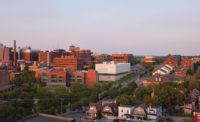Once a preeminent naval shipbuilding site, the sprawling 300-acre Brooklyn Navy Yard on the East River, first established in 1801, is now a diverse community of over 400 businesses and entrepreneurs. Building 77, a 16-story, concrete-and-steel structure, is one of the Yard’s most active job hubs; originally built as a windowless storage and administrative facility in 1942, and renovated by Beyer Blinder Belle in 2017, the building provides one million-square-feet of floor space for dozens of fledgling companies—and one New York City high school program.
Designed by Perkins Eastman, the Brooklyn STEAM Center is located in a 33,000-square-foot space lodged among furniture companies and manufacturing facilities, architecture and design firms, film studios, and a food court that includes a brewery and the famed lox and bagel purveyor, Russ & Daughters. While it seems an unusual place for a public school, the location was a strategic move; the goal of STEAM—one of the latest models for technical high schools, developed in partnership with the Navy Yard—is to teach real-life job skills in a setting where students can learn from industry leaders, and even intern with other building tenants. Qualifying juniors and seniors from eight partnering Brooklyn schools choose to train in one of five professional fields, or “pathways”—computer science, design and engineering, construction technology, culinary arts, and film and media—and split their days between their home schools and STEAM as part of the two year program.
Perkins Eastman’s design objective for STEAM, which takes up an L-shaped chunk of the building’s second and third floors, was to emulate the companies that surround it. “The challenge was to make it less like a school and more like a place of work,” says project architect Michael Palmer. “We wanted to give students agency, and to foster a sense of independence.” To do this, the architects created five unique classrooms, each catering to a specific pathway. For the construction technology and design and engineering workshops, which are clustered next to each other, they removed the existing ceiling slab to fit ductwork and to create double-height rooms with enough space to build out large projects, such as a “tiny house” that was constructed last summer. The film and media area, also two stories, features a sound stage, control room, and recording studio, and culinary arts students—who receive their food handling licenses upon graduating—spend their time in a large teaching kitchen. The computer science room, called the “glass cube” for its significant glazing, appears most like a start-up, with an open plan, movable desks and chairs, and white boards.

The computer science classroom resembles a start-up workspace, with its significant glazing and movable desks and chairs.
The architects removed the upper floor slab to create double height spaces for the construction technology and design and engineering workshops (1 & 2).
Photos © Ty Cole/OTTO
According to principal Christine Schlendorf, promoting transparency was an important way to create a professional environment for students, and to encourage teamwork. “We wanted all pathways to have eyes on each other,” she says, so some classrooms and conference rooms are fully glazed. An open common area with visual access to the kitchen, seminar rooms, administrative offices, and computer lab, also fosters off-the-cuff collaboration. Additionally, by exposing the space’s original columns, steel bracing, and its polished concrete floor, the architects were able to maintain an industrial feel, rather than an academic one.
At a recent open house, the students showcased their projects in a vibrant multi-disciplinary display. The event was catered by those in the culinary program, who took over the common area with tasting booths that represented an international array of cuisines. The school has only been open for a year, but plans to expand into adjacent vacant office space are already percolating, say the architects. “It is not traditional in any sense,” says Palmer. “Here, students are treated like adults.”
Credits
Architect:
Perkins Eastman
115 Fifth Avenue
New York, NY, 10003
212 353 7200
perkinseastman.com
Personnel in architect's firm who should receive special credit:
Christine Schlendorf AIA, Principal-in-Charge, Michael Palmer, Project Architect, Sharon Wong, NCIDQ, Interior Designer
Architect of record:
Perkins Eastman
Engineers:
MEP: Loring Consulting Engineers
Structural: Ysrael Seinuk Engineers
Consultants:
AV, IT, Security & Acoustical: Shen Milsom & Wilke
Food Service: Romano Gatland
Door Hardware: Glen Fisher Group LLC
Construction Manager:
Turner Interiors
Photographer:
Ty Cole/OTTO, Andrew Rugge
Specifications
Glazing:
Other: Acoustical Windows (Film+Media Suite): Krieger
Sliding Window (Kitchen): CR Laurence
Doors:
Metal doors: Pioneer Steel Doors and Frames
Wood doors: Metropolitan Woodwork
Fire-control doors, security grilles: Rated Glass Doors by Technical Glass Products
Hardware:
Locksets: Schlage
Closers: Dorma
Exit devices: Schlage
Pulls: Schlage
Security devices: HID Card Readers
Interior Finishes:
Acoustical ceilings: Armstrong Ultima
Suspension grid: Armstrong Ultima
Demountable partitions: Acme Inscape
Cabinetwork and custom woodwork: Metropolitan Woodwork
Paints and stains: Benjamin Moore
Wall coverings: Acoustical Wall Panels (General): Unika Vaev, Acoustical Wall Panels (Sound Booth): Pinta Acoustics
Paneling: Perforated Wood Wall Panels: Metropolitan Woodwork, Pegboard (Construction Tech Lab): Panel Processing Tempered Hardware
Plastic laminate: Nevamar, WilsonArt
Solid surfacing: Caesarstone
Special surfacing: Dry Erase Surfaces: Chemetal, Glass Markerboards: Aarco Whiteboards
Floor and wall tile: Daltile
Resilient flooring: Kitchen Flooring: Sikafloor
Carpet: Interface
Special interior finishes unique to this project: Diamond Plate Metal Wall Covering: Inpro
Window Shades: Rollease Acmeda
Furnishings:
Office furniture: Global Furniture (BRIDGES II)
Reception furniture: Metropolitan Woodwork
Chairs: Global Furniture (VION, DUET)
Tables: Offices: Global Furniture (TERINA), Work Tables (Shops): Diversified Woodcraft
Upholstery: Curtains (Film+Media): DFB Sales, Rosebrand (Green Screen)
Other furniture: Laminate Lockers: Hollman, Wood Lockers: Metropolitan Woodwork
Lighting:
Interior ambient lighting: RAB Lighting (High-Bays), Focal Point (Interior Cove Lighting)
Downlights: RAB Lighting (linear downlights), RAB Lighting (high-hats), Spectrum Lighting (Film+Media Downlights), Architectural Lighting Works
Tasklighting: ETC (Film+Media Sound Stage Specialty Lighting), Edison Price Lighting Minimax (Film+Media Production Suite)
Dimming system or other lighting controls: Echo
Plumbing:
Water Closets: Kohler
Flushometers: Sloan
Drinking Fountains: Elkay
Eyewash: Bradley, Sidewall Sprinklers @Demountable Partitions: Tyco











Post a comment to this article
Report Abusive Comment